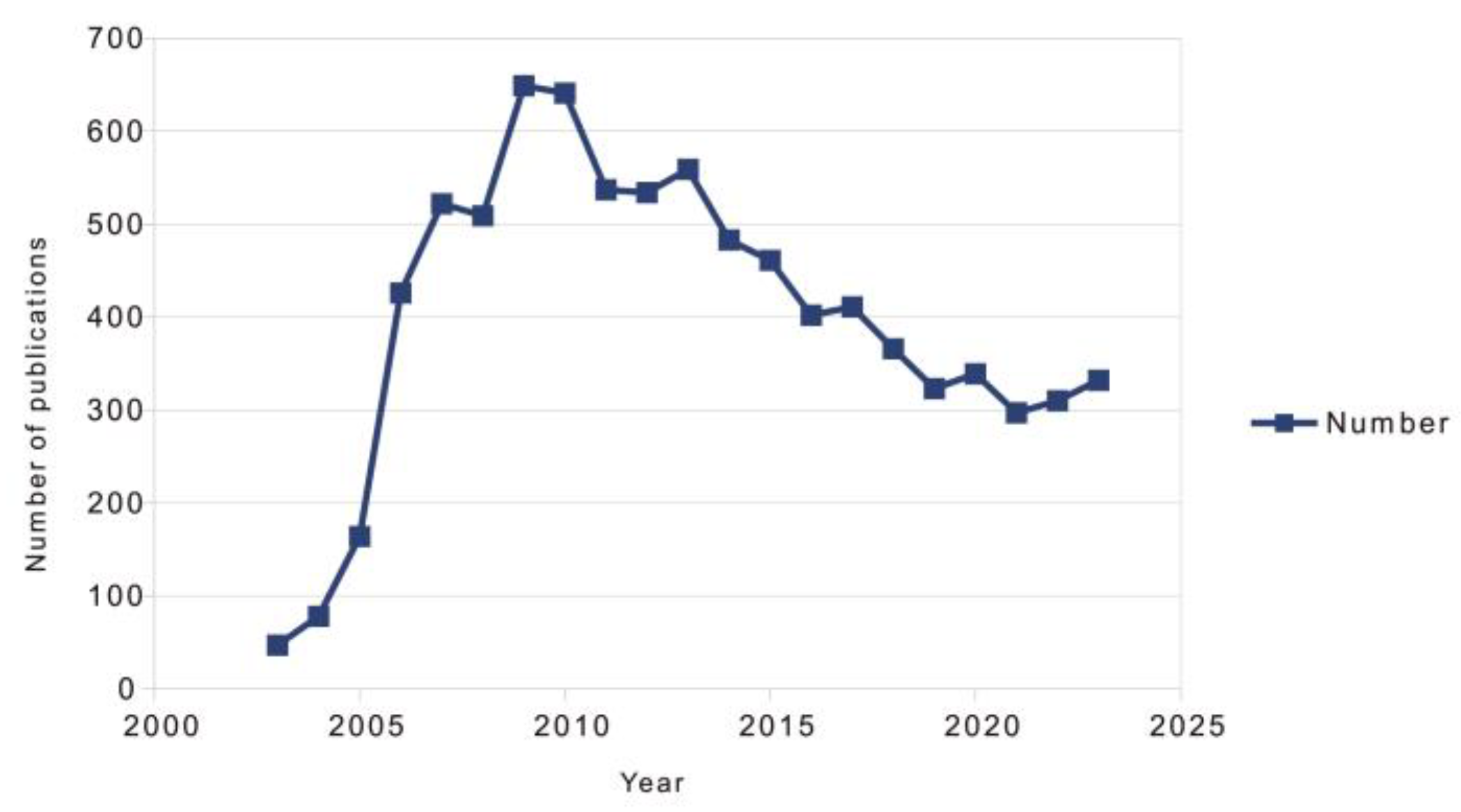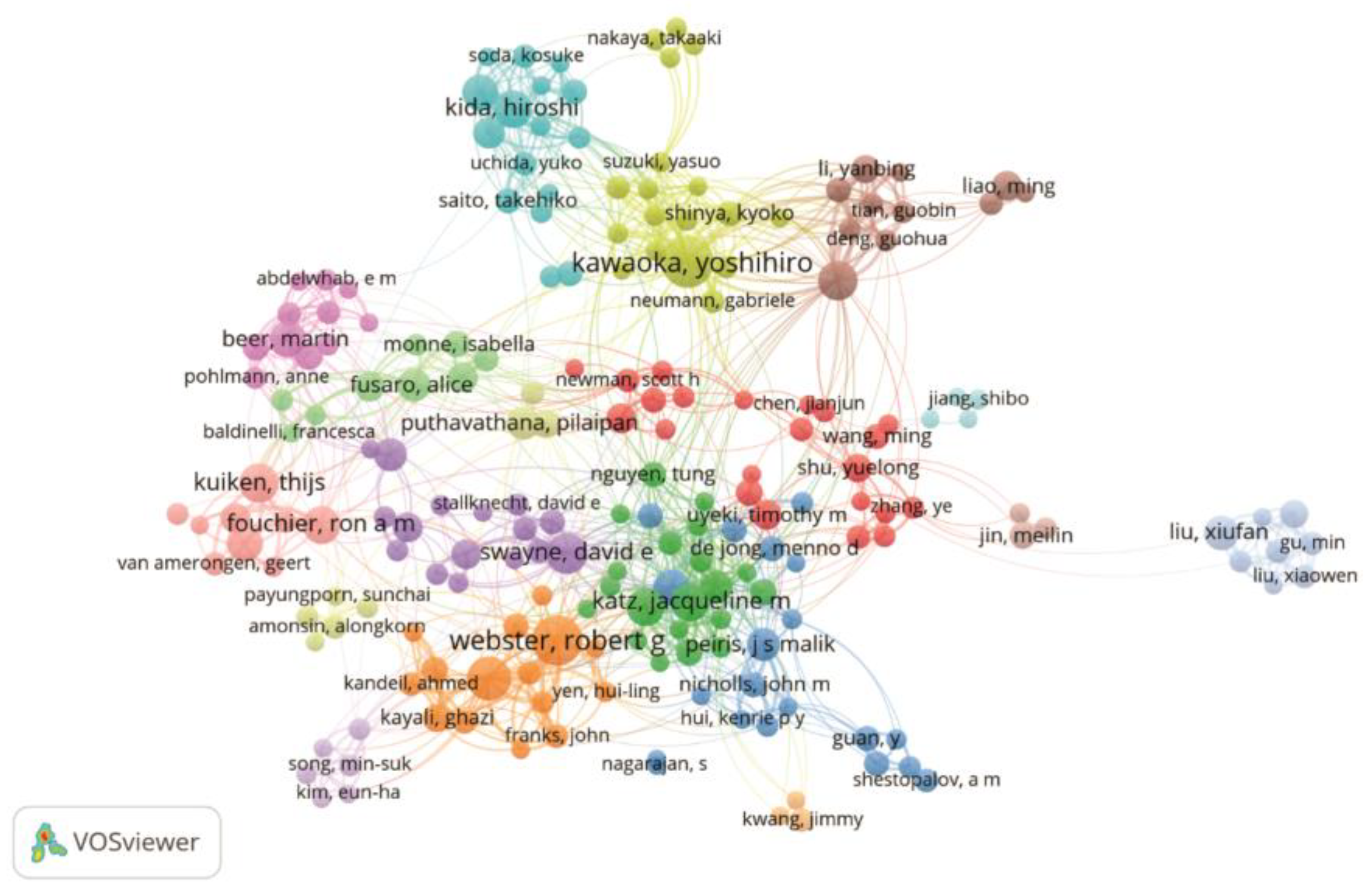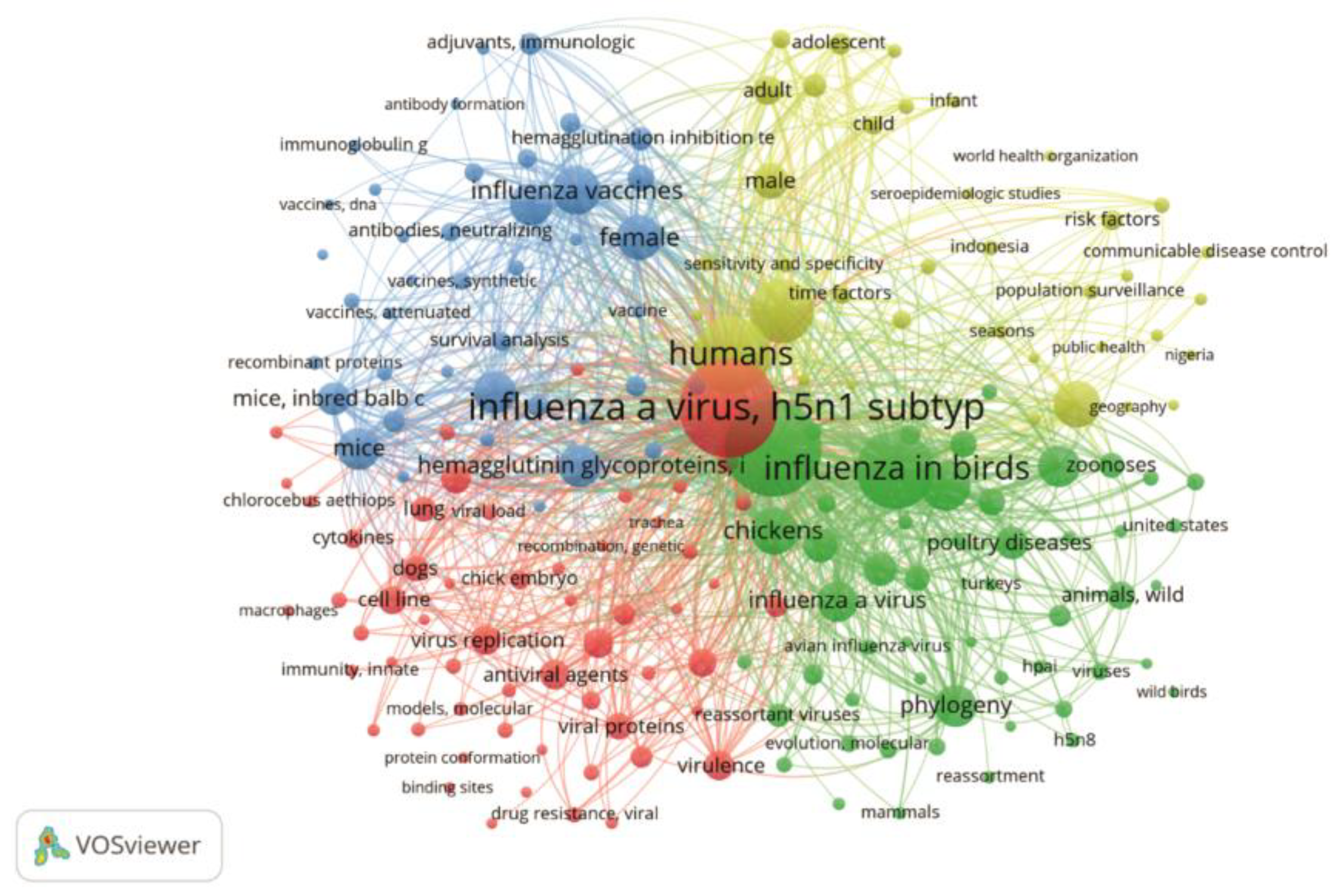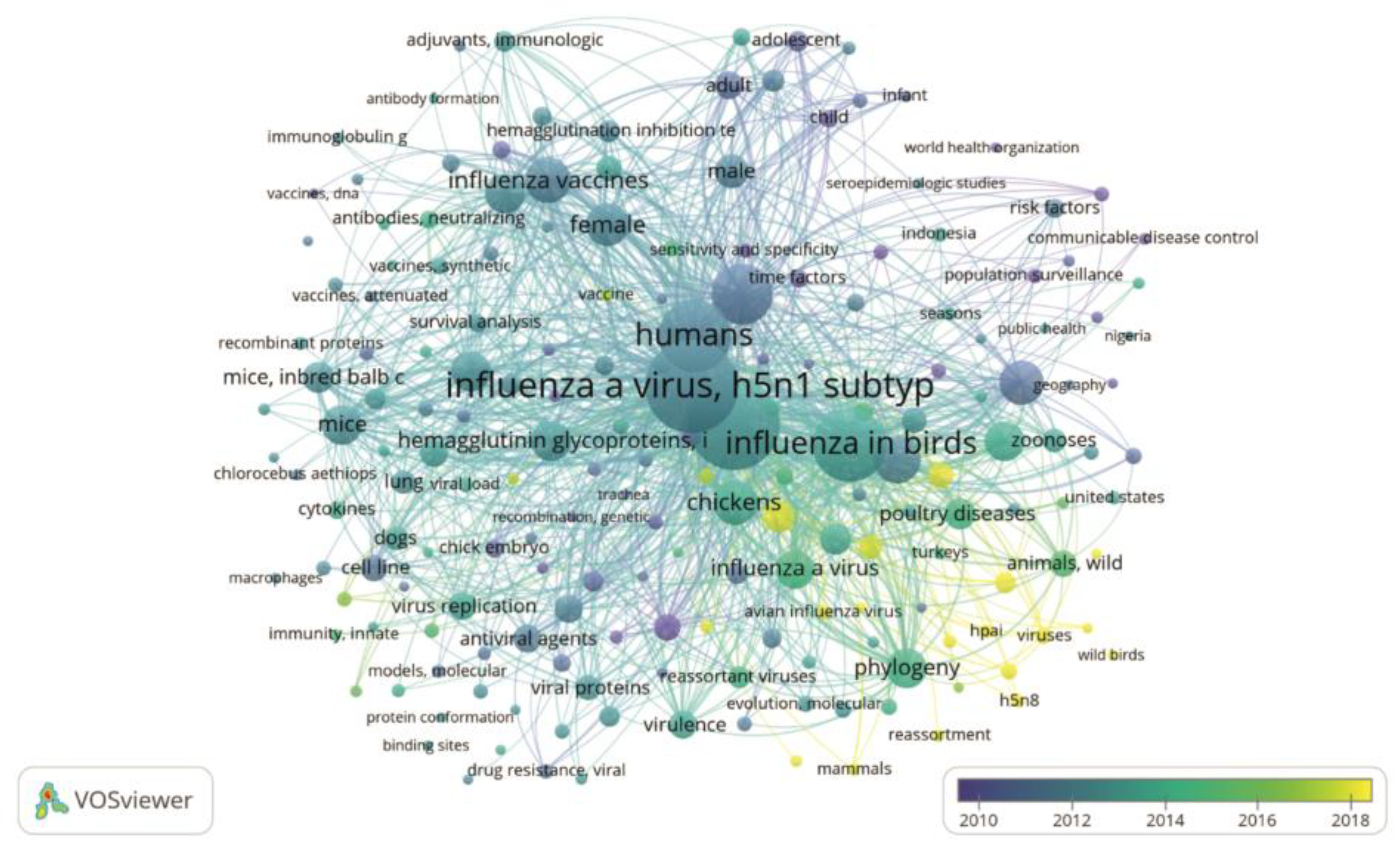Bibliometric Analysis of Highly Pathogenic Avian Influenza Research Globally from 2003 to 2023
Abstract
Introduction
Methods
Source of data
Retrieval of studies from PubMed
Data screening criteria and protocol
Social network analysis
Bibliometric analyses of the data
Statistical analysis
Results
Discussion
Conclusions
Supplementary Materials
Author Contributions
Funding
Institutional Review Board Statement
Data Availability Statement
Conflicts of Interest
References
- Chen, H. H5N1 avian influenza in China. Sci China C Life Sci. 2009, 52, 419–427. [Google Scholar] [CrossRef]
- The Lancet Infectious Diseases. What is the pandemic potential of avian influenza A(H5N1)? Lancet Infect Dis. 2024, 24, 437. [CrossRef]
- Gobbo, F.; Zanardello, C.; Bottinelli, M.; et al. Silent infection of highly pathogenic avian influenza virus (H5N1) clade 2.3.4.4b in a commercial chicken broiler flock in Italy. Viruses. 2022, 14, 1600. [Google Scholar] [CrossRef] [PubMed]
- Meseko, C.; Milani, A.; Inuwa, B.; et al. The evolution of highly pathogenic avian influenza A (H5) in poultry in Nigeria, 2021-2022. Viruses. 2023, 15, 1387. [Google Scholar] [CrossRef]
- Tang, Y.; Wu, P.; Peng, D.; et al. Characterization of duck H5N1 influenza viruses with differing pathogenicity in mallard (Anas platyrhynchos) ducks. Avian Pathol. 2009, 38, 457–467. [Google Scholar] [CrossRef] [PubMed]
- Islam, A.; Islam, S.; Flora, M.S.; et al. Epidemiology and molecular characterization of avian influenza A viruses H5N1 and H3N8 subtypes in poultry farms and live bird markets in Bangladesh. Sci Rep. 2023, 13, 7912. [Google Scholar] [CrossRef]
- Jimenez-Bluhm, P.; Siegers, J.Y.; Tan, S.; et al. Detection and phylogenetic analysis of highly pathogenic A/H5N1 avian influenza clade 2.3.4.4b virus in Chile, 2022. Emerg Microbes Infect. 2023, 12, 2220569. [Google Scholar] [CrossRef]
- Olawuyi, K.; Orole, O.; Meseko, C.; et al. Detection of clade 2.3.4.4 highly pathogenic avian influenza H5 viruses in healthy wild birds in the Hadeji-Nguru wetland, Nigeria 2022. Influenza Other Respir Viruses. 2024, 18, e13254. [Google Scholar] [CrossRef]
- Imai, H.; Dinis, J.M.; Zhong, G.; et al. Diversity of influenza A(H5N1) viruses in infected humans, Northern Vietnam, 2004-2010. Emerg Infect Dis. 2018, 24, 1128–1238. [Google Scholar] [CrossRef] [PubMed]
- Plaza, P.I.; Gamarra-Toledo, V.; Euguí, J.R.; Lambertucci, S.A. Recent changes in patterns of mammal infection with highly pathogenic avian influenza A(H5N1) Virus Worldwide. Emerg Infect Dis. 2024, 30, 444–452. [Google Scholar] [CrossRef]
- Shao, W.; Li, X.; Goraya, M.U.; Wang, S.; Chen, J.L. Evolution of influenza A virus by mutation and re-assortment. Int J Mol Sci. 2017, 18, 1650. [Google Scholar] [CrossRef]
- Word Health Organization. Ongoing avian influenza outbreaks in animals pose risk to humans. Available online: https://www.who.int/news/item/12-07-2023-ongoing-avian-influenza-outbreaks-in-animals-pose-risk-to-humans (accessed on 30 April 2024).
- Food and Agriculture Organization of the United Nations. Global Avian Influenza Viruses with Zoonotic Potential situation update. Available online: https://www.fao.org/animal-health/situation-updates/global-aiv-with-zoonotic-potential/en (accessed on 23 January 2025).
- Thomas, J.K.; Noppenberger, J. Avian influenza: a review. Am J Health Syst Pharm. 2007, 64, 149–165. [Google Scholar] [CrossRef] [PubMed]
- Stern, A.M.; Cetron, M.S.; Markel, H. The 1918-1919 influenza pandemic in the United States: lessons learned and challenges exposed. Public Health Rep. 2010, 125 (Suppl. 3), 6–8. [Google Scholar] [CrossRef]
- Clegg, C.H.; Rininger, J.A.; Baldwin, S.L. Clinical vaccine development for H5N1 influenza. Expert Rev Vaccines. 2013, 12, 767–777. [Google Scholar] [CrossRef]
- El Sahly, H.M.; Keitel, W.A. Pandemic H5N1 influenza vaccine development: an update. Expert Rev Vaccines. 2008, 7, 241–247. [Google Scholar] [CrossRef] [PubMed]
- Steel, J. New strategies for the development of H5N1 subtype influenza vaccines: progress and challenges. BioDrugs. 2011, 25, 285–298. [Google Scholar] [CrossRef] [PubMed]
- Okoroiwu, H.U.; Umoh, E.A.; Asanga, E.E.; et al. Thirty-five years (1986-2021) of HIV/AIDS in Nigeria: bibliometric and scoping analysis. AIDS Res Ther. 2022, 19, 64. [Google Scholar] [CrossRef]
- Fasanmi, O.G.; Odetokun, I.A.; Balogun, F.A.; Fasina, F.O. Public health concerns of highly pathogenic avian influenza H5N1 endemicity in Africa. Vet World. 2017, 10, 1194–1204. [Google Scholar] [CrossRef]
- Polanin, J.R.; Pigott, T.D.; Espelage, D.L.; Grotpeter, J.K. Best practice guidelines for abstract screening large-evidence systematic reviews and meta-analyses. Res Synth Methods. 2019, 10, 330–342. [Google Scholar] [CrossRef]
- Perianes-Rodriguez, A.; Waltman, L.; Van Eck, N.J. Constructing bibliometric networks: a comparison between full and fractional counting. J Informetr. 2016, 10, 1178–1195. [Google Scholar] [CrossRef]
- Sharma, M.; Sarin, A.; Gupta, P.; Sachdeva, S.; Desai, A.V. Journal impact factor: its use, significance and limitations. World J Nucl Med. 2014, 13, 146. [Google Scholar] [CrossRef] [PubMed]
- Romero-Riano, E.; Guerrero-Santander, C.D.; Martinez-Ardila, H.E. Agronomy research co-authorship networks in agricultural innovation systems. Rev UIS Ingenieras. 2021, 20, 61–67. [Google Scholar] [CrossRef]
- Joannis, T.M.; Meseko, C.A.; Oladokun, A.T.; et al. Serologic and virologic surveillance of avian influenza in Nigeria, 2006–2007. Euro Surveill. 2008, 13, 19007. [Google Scholar] [CrossRef]
- Fusaro, A.; Joannis, T.; Monne, I.; et al. Introduction into Nigeria of a distinct genotype of avian influenza virus (H5N1). Emerg Infect Dis. 2009, 15, 445–447. [Google Scholar] [CrossRef]
- Lim, M.K. Global response to pandemic flu: more research needed on a critical front. Health Res Policy Syst. 2006, 4, 8. [Google Scholar] [CrossRef][Green Version]
- Fouchier, R.A.; Herfst, S.; Osterhaus, A.D. Public health and biosecurity. Restricted data on influenza H5N1 virus transmission. Science. 2012, 335, 662–663. [Google Scholar] [CrossRef][Green Version]
- Hirsch, M.S. Biosecurity and censorship: the H5N1 influenza controversy. J Infect Dis. 2012, 205, 1621. [Google Scholar] [CrossRef][Green Version]
- Osterholm, M.T.; Henderson, D.A. Public health and biosecurity. Life sciences at a crossroads: respiratory transmissible H5N1. Science. 2012, 335, 801–802. [Google Scholar] [CrossRef]
- Rehman, S.; Effendi, M.H.; Witaningruma, A.M.; et al. Avian influenza (H5N1) virus, epidemiology and its effects on backyard poultry in Indonesia: a review. F1000Res. 2022, 11, 1321. [Google Scholar] [CrossRef] [PubMed]
- Word Health Organization. Disease Outbreak News 2006 - Nigeria. Available online: https://www.who.int/emergencies/disease-outbreak-news/item/2006_02_08-en (accessed on 25 June 2024).
- Impellizzeri, F.M.; Bizzini, M. Systematic review and meta-analysis: a primer. Int J Sports Phys Ther. 2012, 7, 493–503. [Google Scholar] [PubMed]
- Alahmad, G. Ethical challenges involved in COVID-19 vaccine mandates for children: a systematic review. Vaccines (Basel). 2023, 11, 601. [Google Scholar] [CrossRef]
- Chakraborty, C.; Bhattacharya, M.; Dhama, K. SARS-CoV-2 vaccines, vaccine development technologies, and significant efforts in vaccine development during the pandemic: the lessons learned might help to fight against the next pandemic. Vaccines (Basel). 2023, 11, 682. [Google Scholar] [CrossRef]
- Times Higher Education. Globe's top universities revealed in world's largest and most authoritative university rankings. Available online: https://www.timeshighereducation.com/press-releases/globes-top-universities-revealed-worlds-largest-and-most-authoritative-university (accessed on 30 April 2024).
- Bansal, S.; Mahendiratta, S.; Kumar, S.; Sarma, P.; Prakash, A.; Medhi, B. Collaborative research in modern era: need and challenges. Indian J Pharmacol. 2019, 51, 137–139. [Google Scholar] [CrossRef]
- Roberts, J.A. Funding the global control of bird flu. BMJ. 2006, 332, 189–190. [Google Scholar] [CrossRef] [PubMed]
- Meseko, C.; Globig, A.; Ijomanta, J.; et al. Evidence of exposure of domestic pigs to highly pathogenic avian influenza H5N1 in Nigeria. Sci Rep. 2018, 8, 5900. [Google Scholar] [CrossRef]
- Corrin, L.; Thompson, K.; Hwang, G.-J.; Lodge, J.M. The importance of choosing the right keywords for educational technology publications. Australas J Educ Technol. 2022, 38, 1–8. [Google Scholar] [CrossRef]
- Laleye, A.T.; Bianco, A.; Shittu, I.; et al. Genetic characterization of highly pathogenic avian influenza H5Nx clade 2.3.4.4b reveals independent introductions in Nigeria. Transbound Emerg Dis. 2022, 69, 423–433. [Google Scholar] [CrossRef]
- Shittu, I.; Bianco, A.; Gado, D.; et al. First detection of highly pathogenic H5N6 avian influenza virus on the African continent. Emerg Microbes Infect. 2020, 9, 886–888. [Google Scholar] [CrossRef]
- Coker, T.; Meseko, C.; Odaibo, G.; Olaleye, D. Circulation of the low pathogenic avian influenza subtype H5N2 virus in ducks at a live bird market in Ibadan, Nigeria. Infect Dis Poverty. 2014, 3, 38. [Google Scholar] [CrossRef] [PubMed]
- Sulaiman, L.; Shittu, I.; Fusaro, A.; et al. Live bird markets in Nigeria: a potential reservoir for H9N2 avian influenza viruses. Viruses. 2021, 13, 1445. [Google Scholar] [CrossRef]
- Kuiken, T.; Fouchier, R.; Rimmelzwaan, G.; van den Brand, J.; van Riel, D.; Osterhaus, A. Pigs, poultry, and pandemic influenza: how zoonotic pathogens threaten human health. Adv Exp Med Biol. 2011, 719, 59–66. [Google Scholar] [CrossRef] [PubMed]





© GERMS 2025.
Share and Cite
Meseko, C.; Edet, U.O.; Henshaw, O.; Mkpuma, N.; Olawuyi, K.A.; Archibong, C. Bibliometric Analysis of Highly Pathogenic Avian Influenza Research Globally from 2003 to 2023. Germs 2025, 15, 11-25. https://doi.org/10.18683/germs.2025.1451
Meseko C, Edet UO, Henshaw O, Mkpuma N, Olawuyi KA, Archibong C. Bibliometric Analysis of Highly Pathogenic Avian Influenza Research Globally from 2003 to 2023. Germs. 2025; 15(1):11-25. https://doi.org/10.18683/germs.2025.1451
Chicago/Turabian StyleMeseko, Clement, Uwem Okon Edet, Okoroiwu Henshaw, Nicodemus Mkpuma, Kayode Abraham Olawuyi, and Charles Archibong. 2025. "Bibliometric Analysis of Highly Pathogenic Avian Influenza Research Globally from 2003 to 2023" Germs 15, no. 1: 11-25. https://doi.org/10.18683/germs.2025.1451
APA StyleMeseko, C., Edet, U. O., Henshaw, O., Mkpuma, N., Olawuyi, K. A., & Archibong, C. (2025). Bibliometric Analysis of Highly Pathogenic Avian Influenza Research Globally from 2003 to 2023. Germs, 15(1), 11-25. https://doi.org/10.18683/germs.2025.1451



